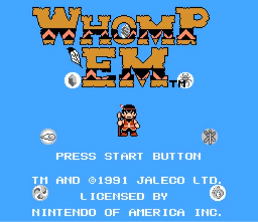Developer: Jaleco
Publisher: Jaleco
Systems: NES
Year of release: 1991
Genre: Platformer
TCU Archive Access: Yes- available for play in Fab Lab
Outside Access: Available from resellers
Time period: Unspecified
Location: Unspecified
Tribe: Unnamed
Character Types: Player character
“Whomp ‘Em is the story of Soaring Eagle, a young Indian Brave who ventures into the world seeking totems for his magic pouch”
– Game Manual Description
The characterization of Soaring Eagle is fairly shallow. No tribe is explicitly named and there is no clear time period or setting. In many places the game alternates between elements that seem to allude to Soaring Eagle’s vaguely defined culture and common fantasy tropes. For example, in-game magical items include both a gourd, which heals the player and could be a reference to the importance of the three sisters to some tribes, and a standard magic potion, which gives the player an extra life. Similarly, the totems Soaring Eagle finds include dart, which simply allows him to throw a spear, and Ice Crystal, which gives him the power to magically freeze enemies. The enemies are generally fantasy-based and include everything from a dragon boss fight to small flying pink elephants.
TBA
Whomp ‘Em is a side scrolling action story. It is the first video game featuring a Native American protagonist. The game is a visual reskin of the Japanese game Saiyūki World 2: Tenjōkai no Majin, meant to better appeal to a Western market. As a visual reskin, all of the game mechanics and the game progression remain the same- only the audio and some images have been changed (pandas were switched to grizzlies, for example). Thus, both Whomp ‘Em and Saiyūki World 2: Tenjōkai no Majin can be considered adaptations of Wonder Boy in Monster Land and based on the Journey to the West novel.
The protagonist in the original Saiyūki World 2: Tenjōkai no Majin was Sun Wukong, a.k.a. the Monkey King. The character was changed for the North American version to a Native American Indian named Soaring Eagle. His goal is to fill his magic pouch with totems. These totems are acquired by completing stages, and give him power to help complete the other stages. It is worth observing that, with no specific tribe named, Soaring Eagle’s magic pouch and totems exist outside the framework of any actual religion or set of spiritual practices.

Whomp ‘Em plays similarly other popular games of its time, namely the Mega Man series and the Super Mario Bros series. Like Mega Man, players must defeat bosses and collect abilities/powers that they can use to defeat other stages and bosses. There are a total of 8 stages in Whomp ‘Em. This includes a first stage, which must be completed before accessing the main screen and gaining access to six other stages. Once the six stage bosses are defeated and the six totems are collected, players are taken to defeat the final stage. The game also involves jumping over enemies, navigating platforms, and moving across a primarily side-scrolling environment, similar to the early Super Mario Bros. games.
The objects and creatures spread throughout the game do seem to references any specific actual location or time period. The player finds themselves avoiding floating eyeballs, floating hands, bouncing mushrooms, and other oddities. The instruction manual (provided below in the Additional Content section) does explain (to an extent) what certain items are and how they might help the protagonist.
The storyline is incredibly limited and only conveyed via instructional manual (see Page 2 of the instructional manual below in the Additional Content section). Like many early platformers, this game’s learning curve is steep and the controls can be imprecise. While playthroughs and speed runs can complete the game in thirty minutes or less, playing the game as a new player may take substantially longer.
.
TBA
To our knowledge, there are no scholarly sources extensively citing Whomp ‘Em. It is briefly mentioned in several articlesas potentially the first game with a Native American protagonist.
Sample Game Screens:
Instruction Manual:
Gameplay Video:













